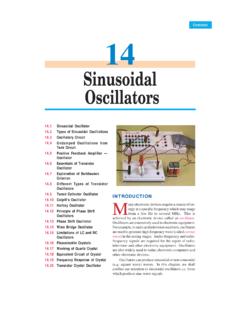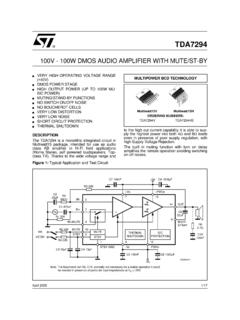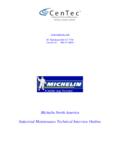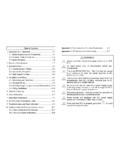Transcription of Amplifiers with Negative Feedback - Talking …
1 Amplifiers with Negative Feedback 335 of Negative VoltageFeedback In Amplifiers of Negative Voltage Feed-back amplifier of Negative VoltageFeedback Circuit of Negative CurrentFeedback Gain with NegativeCurrent Feedback of Negative CurrentFeedback Analysis of Gain of Impedance of Impedance of of AmplifierINTRINTRINTRINTRINTRODUCTIONODU CTIONODUCTIONODUCTIONODUCTIONA practical amplifier has a gain of nearly onemillion its output is one million times theinput. Consequently, even a casual disturbanceat the input will appear in the amplified form in theoutput. There is a strong tendency in Amplifiers to in-troduce hum due to sudden temperature changes or strayelectric and magnetic fields. Therefore, every high gainamplifier tends to give noise along with signal in itsoutput.
2 The noise in the output of an amplifier is unde-sirable and must be kept to as small a level as noise level in Amplifiers can be reduced con-siderably by the use of Negative Feedback by in-jecting a fraction of output in phase opposition to theinput signal. The object of this chapter is to considerthe effects and methods of providing Negative feedbackin transistor FeedbackThe process of injecting a fraction of output energy ofAmplifiers withNegative Feedback13336 Principles of Electronicssome device back to the input is known as principle of Feedback is probably as old as the invention of first machine but it is only some50 years ago that Feedback has come into use in connection with electronic circuits. It has been foundvery useful in reducing noise in Amplifiers and making amplifier operation stable.
3 Depending uponwhether the Feedback energy aids or opposes the input signal, there are two basic types of Feedback inamplifiers viz positive Feedback and Negative Feedback .(i) Positive Feedback . When the Feedback energy (voltage or current) is in phase with the inputsignal and thus aids it, it is called positive Feedback . This is illustrated in Fig. Both amplifierand Feedback network introduce a phase shift of 180 . The result is a 360 phase shift around theloop, causing the Feedback voltage Vf to be in phase with the input signal positive Feedback increases the gain of the amplifier . However, it has the disadvantages ofincreased distortion and instability. Therefore, positive Feedback is seldom employed in important use of positive Feedback is in oscillators. As we shall see in the next chapter, ifpositive Feedback is sufficiently large, it leads to oscillations.
4 As a matter of fact, an oscillator is adevice that converts power into power of any desired frequency.(ii) Negative Feedback . When the Feedback energy (voltage or current) is out of phase with theinput signal and thus opposes it, it is called Negative Feedback . This is illustrated in Fig. As youcan see, the amplifier introduces a phase shift of 180 into the circuit while the Feedback network is sodesigned that it introduces no phase shift ( , 0 phase shift). The result is that the Feedback voltageVf is 180 out of phase with the input signal Feedback reduces the gain of the amplifier . However, the advantages of Negative feed-back are: reduction in distortion, stability in gain, increased bandwidth and improved input and outputimpedances. It is due to these advantages that Negative Feedback is frequently employed in with Negative Feedback 337 Principles of Negative Voltage Feedback In AmplifiersA Feedback amplifier has two parts viz an amplifier and a Feedback circuit.
5 The Feedback circuitusually consists of resistors and returns a fraction of output energy back to the input. Fig. *showsthe principles of Negative voltage Feedback in an amplifier . Typical values have been assumed tomake the treatment more illustrative. The output of the amplifier is 10 V. The fraction mv of thisoutput 100 mV is fedback to the input where it is applied in series with the input signal of 101 mV. Asthe Feedback is Negative , therefore, only 1 mV appears at the input terminals of the to Fig. , we have,Gain of amplifier without Feedback , Av=10 V10, 0001mV=Fig. of output voltage fedback, mv=100 V=Gain of amplifier with Negative Feedback , Avf=10 V100101 mV=The following points are worth noting :(i)When Negative voltage Feedback is applied, the gain of the amplifier is **reduced. Thus, thegain of above amplifier without Feedback is 10,000 whereas with Negative Feedback , it is only 100.
6 (ii)When Negative voltage Feedback is employed, the voltage actually applied to the amplifieris extremely small. In this case, the signal voltage is 101 mV and the Negative Feedback is 100 mV sothat voltage applied at the input of the amplifier is only 1 mV.(iii)In a Negative voltage Feedback circuit, the Feedback fraction mv is always between 0 and 1.(iv)The gain with Feedback is sometimes called closed-loop gain while the gain without feed-back is called open-loop gain. These terms come from the fact that amplifier and Feedback circuitsform a loop . When the loop is opened by disconnecting the Feedback circuit from the input, theamplifier's gain is Av, the open-loop gain. When the loop is closed by connecting the feedbackcircuit, the gain decreases to Avf , the closed-loop gain.*Note that amplifier and Feedback circuits are connected in series-parallel.
7 The inputs of amplifier andfeedback circuits are in series but the outputs are in parallel. In practice, this circuit is widely used.**Since with Negative voltage Feedback the voltage gain is decreased and current gain remains unaffected, thepower gain Ap (= Av Ai) will decrease. However, the drawback of reduced power gain is offset by theadvantage of increased Principles of Gain of Negative Voltage Feedback AmplifierConsider the Negative voltage Feedback amplifier shown in Fig. The gain of the amplifierwithout Feedback is Av. Negative Feedback is then applied by feeding a fraction mv of the outputvoltage e0 back to amplifier input. Therefore, the actual input to the amplifier is the signal voltage egminus Feedback voltage mv e0 ,Actual input to amplifier =eg mv e0 The output e0 must be equal to the input voltage eg mv e0 multiplied by gain Av of theamplifier ,(eg mv e0) Av=e0orAveg Av mv e0=e0ore0 (1 + Av mv)=Av egor0gee=1vvvAAm+Fig.
8 E0/eg is the voltage gain of the amplifier with Feedback . Voltage gain with Negative Feedback isAvf=1vvvAAm+It may be seen that the gain of the amplifier without Feedback is Av. However, when negativevoltage Feedback is applied, the gain is reduced by a factor 1 + Av mv. It may be noted that negativevoltage Feedback does not affect the current gain of the The voltage gain of an amplifier without Feedback is 3000. Calculate the volt-age gain of the amplifier if Negative voltage Feedback is introduced in the circuit. Given that feed-back fraction mv = 3000,mv = Voltage gain with Negative Feedback isAvf= ++ = 97 Amplifiers with Negative Feedback 339 Example The overall gain of a multistage amplifier is 140. When Negative voltage feed-back is applied, the gain is reduced to Find the fraction of the output that is fedback to 140,A f = mv be the Feedback fraction.
9 Voltage gain with Negative Feedback isA f=1vvAAm + =1401140m + + 2450 m = 140 m = =120 Example When Negative voltage Feedback is applied to an amplifier of gain 100, theoverall gain falls to 50.(i)Calculate the fraction of the output voltage fedback.(ii)If this fraction is maintained, calculate the value of the amplifier gain required if the overallstage gain is to be (i)Gain without Feedback , A =100 Gain with Feedback , A f=50 Let mv be the fraction of the output voltage f=1 AAm +or50 =1001 100m +or50 + 5000 m =100orm =100505000 = (ii)A f= 75 ;m = ;A = ?A f=1 AAm +or75 = +or75 + A =A A = = 300 Example with a Negative voltage Feedback , an amplifier gives an output of 10 V with aninput of V. When Feedback is removed, it requires V input for the same output.
10 Calculate (i)gain without Feedback (ii) Feedback fraction (i)Gain without Feedback , A = 10 = 40(ii)Gain with Feedback , A f= 10 = 20340 Principles of ElectronicsNowA f=1 AAm +or20 =40140m +or20 + 800 m =40orm =4020800 =140 Example The gain of an amplifier without Feedback is 50 whereas with Negative voltagefeedback, it falls to 25. If due to ageing, the amplifier gain falls to 40, find the percentage reductionin stage gain (i) without Feedback and (ii) with Negative f=1vAAm +or25 =50150m +orm = 1/50(i) Without Feedback . The gain of the amplifier without Feedback is 50. However, due toageing, it falls to 40. %age reduction in stage gain =504010050 = 20%(ii) with Negative Feedback . When the gain without Feedback was 50, the gain with negativefeedback was 25. Now the gain without Feedback falls to 40.
















